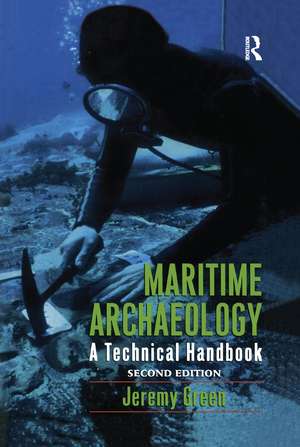Maritime Archaeology: A Technical Handbook, Second Edition
Autor Jeremy Greenen Limba Engleză Paperback – 30 iun 2020
| Toate formatele și edițiile | Preț | Express |
|---|---|---|
| Paperback (1) | 378.22 lei 6-8 săpt. | |
| Taylor & Francis – 30 iun 2020 | 378.22 lei 6-8 săpt. | |
| Hardback (1) | 771.95 lei 6-8 săpt. | |
| Taylor & Francis – 15 iun 2009 | 771.95 lei 6-8 săpt. |
Preț: 378.22 lei
Nou
Puncte Express: 567
Preț estimativ în valută:
72.37€ • 75.76$ • 59.88£
72.37€ • 75.76$ • 59.88£
Carte tipărită la comandă
Livrare economică 05-19 aprilie
Preluare comenzi: 021 569.72.76
Specificații
ISBN-13: 9780367605605
ISBN-10: 0367605600
Pagini: 490
Dimensiuni: 152 x 229 x 25 mm
Greutate: 0.65 kg
Ediția:Nouă
Editura: Taylor & Francis
Colecția Routledge
Locul publicării:Oxford, United Kingdom
ISBN-10: 0367605600
Pagini: 490
Dimensiuni: 152 x 229 x 25 mm
Greutate: 0.65 kg
Ediția:Nouă
Editura: Taylor & Francis
Colecția Routledge
Locul publicării:Oxford, United Kingdom
Recenzii
"The second edition of this handbook includes information on topics such as how to extract as much information as possible from a site, how to record and document data, and how to act ethically and responsibly with the artifact. - Sea Technology July 2004
"This is a revised version of the edition published in 1989, which was one of the few books that dealt with the practical issues of maritime archaeology at that time. This version is a more complete, detailed and modernised approach and is a 'must-have' publication for students and archaeologists without experience in archaeological excavation. It is also an important reference for more experienced ones. This handbook gives the new generation of students a modus operandi in the field of maritime archaeology from a technical and technological point of view, with a fluent and comprehensive style, easily accessible to new readers." Paola Palma, The Archaeologist
"Jeremy Green's systematic overview of maritime archaeology offers a step-by-step description of this fast-growing field. With new information about the use of computers and Global Positioning Systems, the second edition of this handbook shows how to extract as much information as possible from a site, how to record and document the data, and how to act ethically and responsibly with the artefacts. Treating underwater archaeology as a discipline, the book demonstrates how archaeologists, 'looters,' academics, and governments interact and how the market for archaeological artefacts creates obstacles and opportunities for these groups. Well illustrated and comprehensive in its approach to the subject, this book provides an essential foundation for everybody interested in underwater environments, submerged land structures, and conditions created by sea level changes." Jan-Erik Nilsson, Gotheborg.com
Praise for the First Edition: "I found many useful tips on specific methods, and can recommend this book highly as a reference for anyone wishing to become familiar with widely-used underwater site survey and recording methods...Useful methods are presented for locating the position of sites, for mapping site features, and for controlled underwater excavation." JOURNAL OF FIELD ARCHAEOLOGY
"Overall the book achieves what it sets out to do: to present technical information of maritime archaeology based on Jeremy Green's experience.the book has great strengths in presenting the basics of underwater field techniques to the archaeologist. The book will be used as a handy reference work that is ideal to take on a field trip." Iain Stuart, Australian Archeology
"This is a revised version of the edition published in 1989, which was one of the few books that dealt with the practical issues of maritime archaeology at that time. This version is a more complete, detailed and modernised approach and is a 'must-have' publication for students and archaeologists without experience in archaeological excavation. It is also an important reference for more experienced ones. This handbook gives the new generation of students a modus operandi in the field of maritime archaeology from a technical and technological point of view, with a fluent and comprehensive style, easily accessible to new readers." Paola Palma, The Archaeologist
"Jeremy Green's systematic overview of maritime archaeology offers a step-by-step description of this fast-growing field. With new information about the use of computers and Global Positioning Systems, the second edition of this handbook shows how to extract as much information as possible from a site, how to record and document the data, and how to act ethically and responsibly with the artefacts. Treating underwater archaeology as a discipline, the book demonstrates how archaeologists, 'looters,' academics, and governments interact and how the market for archaeological artefacts creates obstacles and opportunities for these groups. Well illustrated and comprehensive in its approach to the subject, this book provides an essential foundation for everybody interested in underwater environments, submerged land structures, and conditions created by sea level changes." Jan-Erik Nilsson, Gotheborg.com
Praise for the First Edition: "I found many useful tips on specific methods, and can recommend this book highly as a reference for anyone wishing to become familiar with widely-used underwater site survey and recording methods...Useful methods are presented for locating the position of sites, for mapping site features, and for controlled underwater excavation." JOURNAL OF FIELD ARCHAEOLOGY
"Overall the book achieves what it sets out to do: to present technical information of maritime archaeology based on Jeremy Green's experience.the book has great strengths in presenting the basics of underwater field techniques to the archaeologist. The book will be used as a handy reference work that is ideal to take on a field trip." Iain Stuart, Australian Archeology
Descriere
Jeremy Green's systematic overview of maritime archaeology offers a step-by-step description of this fast-growing field.
